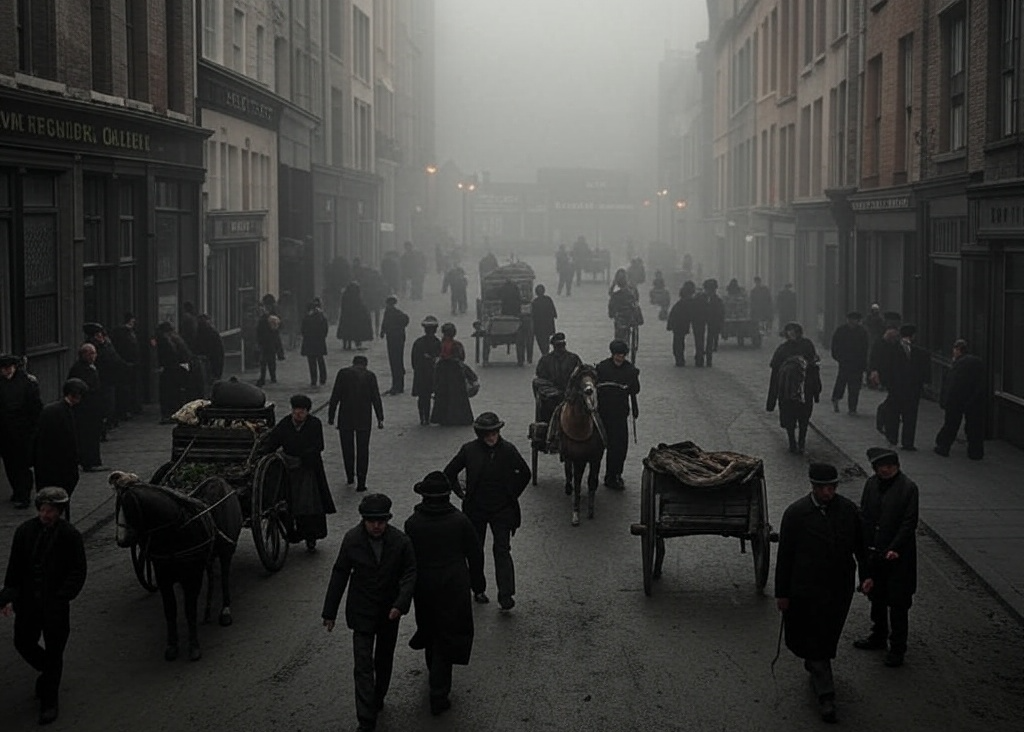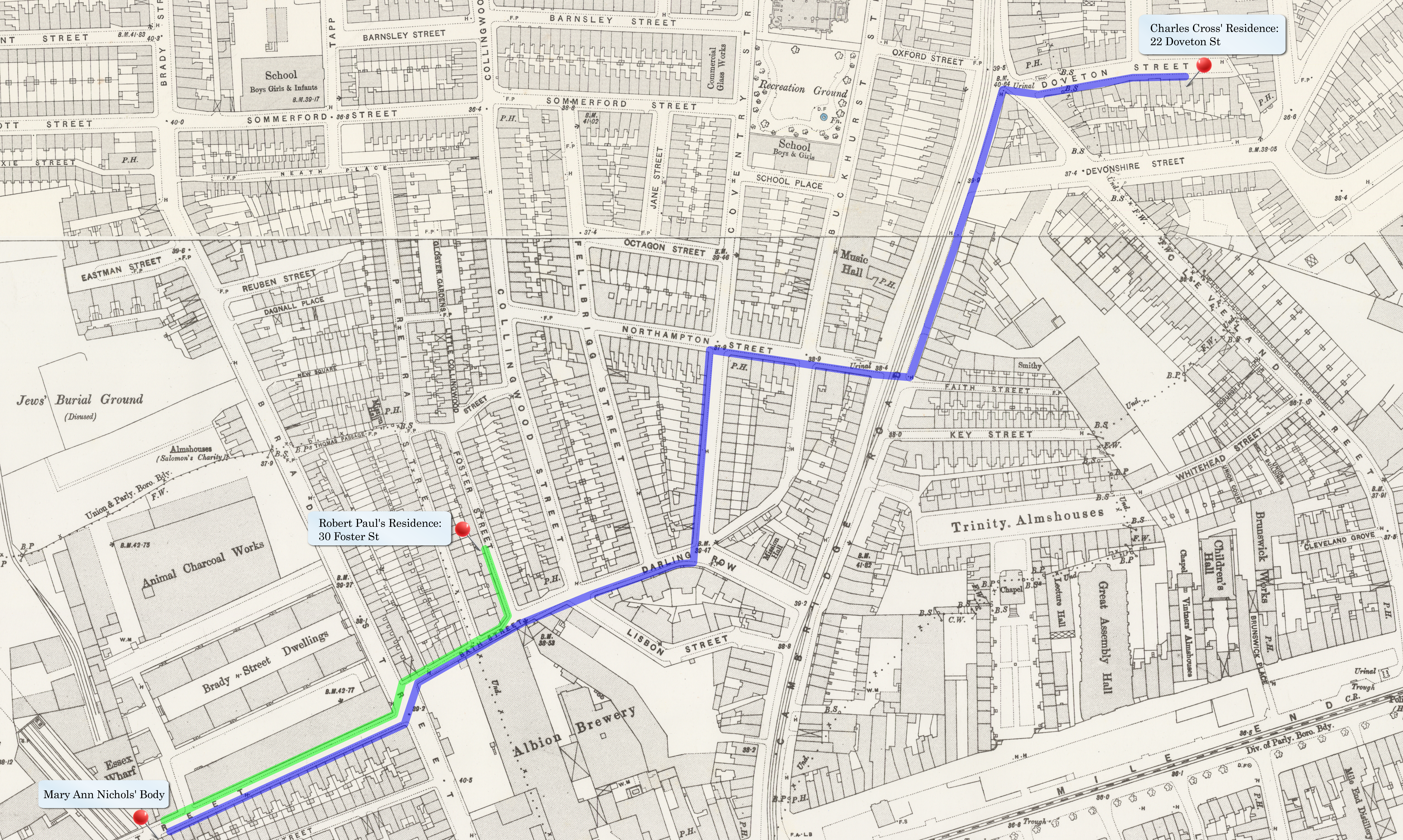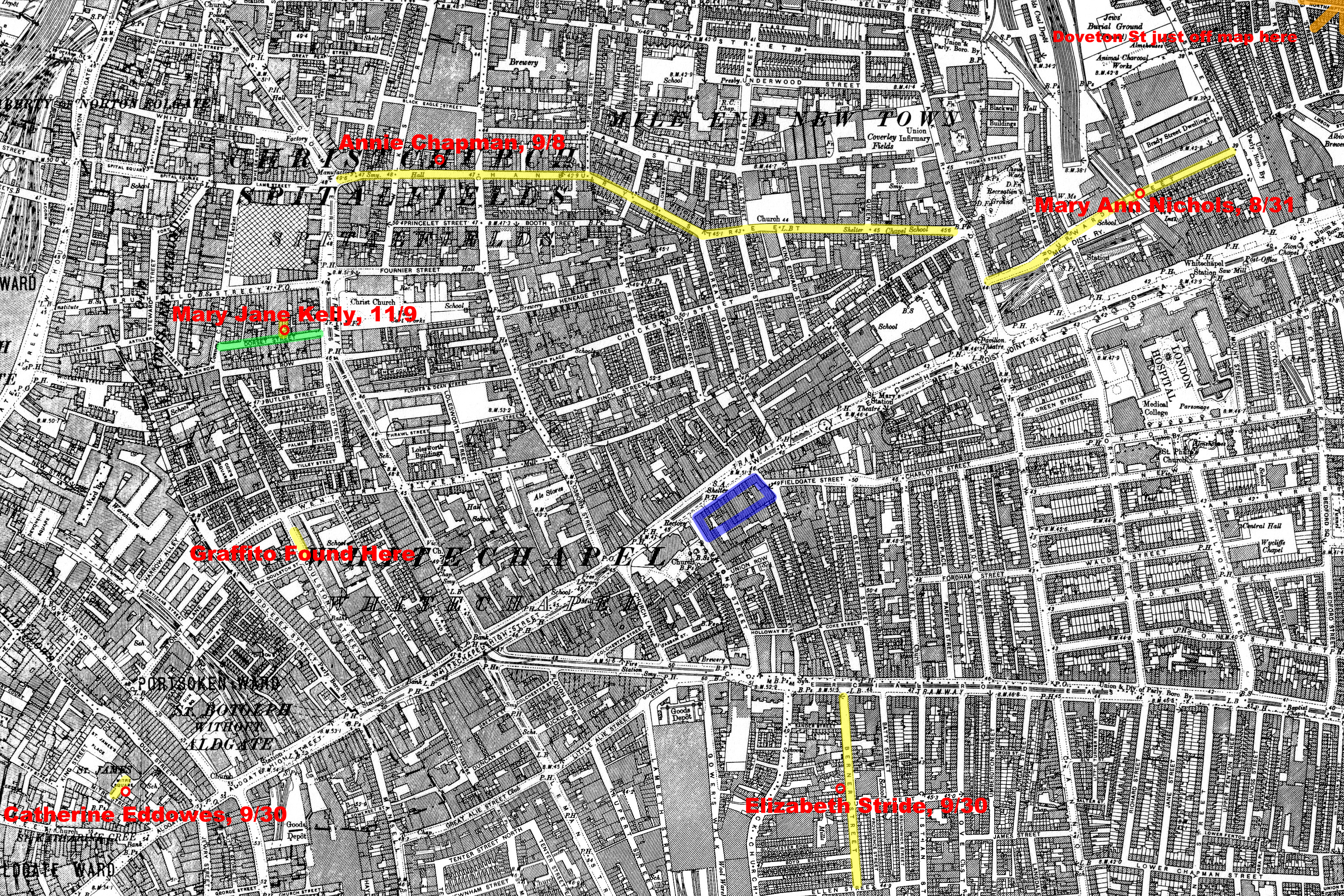Unmasking Jack the Ripper: A Fresh Investigation into the Whitechapel Murders, Part 7
Posted on 06/23/2025 at The Curmudgeon’s Chronicle

The Prosecution’s Rebuttal – Why Charles Cross Is Still the Ripper
In Part 6, I named Charles Cross – also known as Charles Allen Lechmere – as my top suspect for Jack the Ripper, the man behind the brutal murders of the canonical five in Whitechapel, 1888. I laid out the case: his undeniable presence at Mary Ann Nichols’ crime scene, his suspicious behavior, his proximity to every murder, and the chilling alignment of the killings with his life as a carman. The defense stepped up, arguing Cross was an innocent witness caught in the wrong place at the wrong time – a working man wrongly accused by this investigation. They claimed the timeline was too tight, his lack of blood too telling, his name choice a mere quirk, and his proximity unremarkable. They questioned his anatomical skill and pointed to mismatched witness descriptions, insisting he lived a quiet life thereafter.
As the prosecutor in this historical courtroom, I’m here to deliver the final word before you, the jury, render your verdict. I’ll dismantle the defense’s arguments with the precision of a surgeon’s knife, using only 1888 evidence to prove that Charles Cross remains the most likely Ripper. This isn’t a game of speculation – it’s a robust case built on the facts of that blood-soaked autumn. Let’s return to Whitechapel and close this case.
The Prosecution’s Rebuttal: Cross Remains the Ripper
The defense has woven a narrative of innocence around Charles Cross, but their arguments crumble under scrutiny. Let’s address each point, reinforcing why Cross is Jack the Ripper with the cold, hard evidence of 1888.
1. The Tight Timeline at Nichols’ Scene – Not a Defense, but a Trap
The defense claims the timeline at Nichols’ murder – 3:37 to 3:40 a.m. for her death (Dr. Llewellyn, inquest, September 3, 1888) – leaves Cross no time to kill, mutilate, and clean himself before Robert Paul arrived 40 yards behind him at 3:40 a.m. They argue he was simply a worker passing through Buck’s Row on his way to Pickfords. But this tight timeline isn’t a shield – it’s a noose, and Cross’s own words tighten it further. Nichols’ throat was slashed twice, her abdomen cut, and she was dead by 3:40 a.m. (inquest). The Ripper’s method, seen across all five murders, was swift – throat cuts to kill, then mutilation (Dr. Phillips, Chapman inquest). This could take mere minutes, especially in the dark, where Cross could have acted before Paul’s approach. PC John Neil arrived at 3:45 a.m., noting blood still oozing, meaning Nichols was killed moments before Cross was seen standing over her (inquest).
Cross claimed Paul was “about 40 yards away” when he heard his footsteps, implying Paul was close behind and limiting Cross’s time alone with Nichols (inquest, The Echo, September 3, 1888). But this claim unravels under scrutiny. Paul lived at 30 Foster Street, just 0.4 miles from Cross’s 22 Doveton Street, and their routes to work likely overlapped on Bath Street before converging on Buck’s Row – a straight, narrow street with no side alleys (see attached historical map). If Paul was truly 40 yards behind, they’d have been walking almost in tandem, yet Paul didn’t see Cross until he was already standing over Nichols’ body, halfway down Buck’s Row (inquest; Lloyd’s Weekly, September 2, 1888). At 3:40 a.m., with gas lamps 40 yards apart and dim, visibility was poor, but Buck’s Row’s straight path means Paul should have seen Cross walking ahead or approaching the body – unless Cross was already there, lingering longer than he admitted. If Cross arrived at 3:37 a.m., he’d have had 3 minutes to kill Nichols, mutilate her, and compose himself – more than enough for the Ripper’s swift method.
Moreover, the absence of any fleeing suspect makes the defense’s scenario improbable. Buck’s Row was 200 yards long, with Nichols’ body found halfway – 100 yards from either end. If a third party killed Nichols at 3:37 a.m. and fled, they’d have had to run 100 yards east toward Brady Street – straight into Cross and Paul, who entered from that direction at 3:40 a.m. – or west toward Baker’s Row, risking detection on Whitechapel Road, where police presence was heightened after earlier murders. Yet no one reported seeing or hearing anyone flee – neither Cross, Paul, nor PC Neil, who patrolled every 30 minutes and passed at 3:15 a.m., returning at 3:45 a.m. (inquest). Residents like Emma Green, living adjacent to the murder site, heard nothing (inquest). In 1888, hard-soled boots on cobblestone streets would have echoed in the quiet of 3:37 a.m., yet Cross, who heard Paul’s footsteps 40 yards away, reported no other sounds (inquest). This silence, combined with the police presence and the tight window, makes the possibility of anyone else killing Nichols vanishingly slim – leaving Cross, the only man undeniably at the scene, as the most logical culprit. Cross’s 40-yard claim looks like a deliberate attempt to minimize his time alone with Nichols, deflecting suspicion by suggesting Paul was always close behind. But Paul’s failure to see him earlier suggests Cross was in Buck’s Row longer, giving him the window to kill. If Cross were innocent, we might expect him to react with urgency – shouting for help, waking nearby residents like Emma Green, or rushing to find a policeman. Instead, he calmly examined Nichols, waited for Paul, and casually continued to work after reporting to Mizen (inquest). This composure, starkly contrasting Paul’s fright (inquest), suggests the nerve of a killer who stayed to control the narrative – not an innocent man caught off guard.

This map, derived from the 1895/96 London Five Feet to a Mile map (National Library of Scotland), illustrates the Whitechapel area during the Jack the Ripper investigation. It marks the residences of Charles Cross and Robert Paul, the location where Mary Ann Nichols' body was found, and their commute routes, with Cross' route in blue and Paul's in green, overlapping on Bath Street before proceeding to the crime scene via Brady Street.
2. No Blood on Cross – Not Innocence, but Calculation
The defense points to the lack of blood on Cross, arguing the killer would have been splashed, as Nichols’ throat was cut (inquest). They note Inspector Abberline found no blood on suspects like Barnett either (MEPO 3/140). But this assumes a messy, frantic killer, not a calculated one. Nichols’ wounds were precise – two throat cuts, left to right, and abdominal slashes (inquest). In the dark of Buck’s Row, with gas lamps 40 yards apart, Cross could have avoided significant blood spray by standing behind her, cutting her throat while she was on the ground – a method consistent with later murders (e.g., Chapman, Dr. Phillips, inquest). Cross claimed he saw no blood, despite standing “where the woman was” (inquest), yet Neil saw it oozing minutes later. This discrepancy suggests Cross was either lying or had already cleaned himself – his carman’s apron could have caught splatter, easily discarded or wiped in the shadows before Paul arrived. The defense’s comparison to Barnett is irrelevant – Barnett wasn’t at a crime scene minutes after a murder; Cross was. The lack of blood doesn’t exonerate him – it points to a killer who knew how to manage his escape.
3. The Name Discrepancy – Not a Quirk, but a Red Flag
The defense dismisses Cross using “Charles Cross” at the inquest instead of his legal name, “Lechmere,” as a mere quirk, noting he used his stepfather’s surname (1861 census) and gave his correct address and occupation (inquest). But this isn’t a casual oversight – it’s a deliberate choice in the context of a murder investigation. Cross lived as Charles Allen Lechmere in census records (e.g., 1891 census), marriage records, and his children’s births. “Cross” was a name from his childhood, not his legal identity in 1888. At an inquest for a woman whose murder he claimed to have witnessed, why use an alias at all, even a familiar one? The defense argues there’s no evidence of intent to deceive, but giving a name not tied to his current life – while still providing his address – suggests an attempt to create distance from the investigation. If the police had dug deeper into “Charles Lechmere,” they might have found patterns in his movements. This choice, paired with his Mizen discrepancy, paints a picture of a man trying to obscure his tracks.
5. Proximity and Timing – Not Unremarkable, but a Pattern
The defense argues Cross’s proximity to the murder sites – 0.5 to 1.5 miles from Doveton Street, 0.4 to 0.7 miles from his mother’s 147 Cable Street – is unremarkable, as thousands lived in the East End, including Barnett and Kosminski. They also claim the timing of the double event (1:00–1:45 a.m.) and Kelly’s murder (3:00 a.m.) doesn’t uniquely fit Cross’s schedule, as many workers had Saturday nights off. But this misses the forest for the trees. Cross’s proximity isn’t just about distance – it’s about consistency. He lived 0.5 miles from Nichols, 0.8 miles from Chapman, 1.2 miles from Stride, 1.5 miles from Eddowes, and 0.9 miles from Kelly, with his mother’s Cable Street home even closer (0.4–0.7 miles). No other suspect has such a tight geographic web across all murders – Barnett was closer to Kelly (0.3 miles) but farther from Nichols (1 mile), and Kosminski’s Sion Square (0.5–0.7 miles) doesn’t cover Nichols as closely (0.9 miles). Cross’s commute to Pickfords’ depot in Broad Street likely took him near Buck’s Row and Hanbury Street, and his night off for the double event (Saturday into Sunday) aligns perfectly with Stride and Eddowes. Kelly’s murder on a Friday morning (3:00 a.m.) fits his early hours – he was up by 3:30 a.m. for Nichols. This isn’t coincidence; it’s a pattern of opportunity only Cross matches across all five killings.
6. Lack of Anatomical Skill – Not a Barrier, but a Misunderstanding
The defense claims Cross’s lack of a flesh-cutting trade as a carman undermines the progression theory, as Eddowes’ “surgical skill” (Dr. Brown, inquest) and Kelly’s precision (Dr. Phillips, inquest) suggest anatomical knowledge he likely didn’t have, unlike Barnett, a fishmonger. But this overestimates the skill needed. Nichols’ cuts were crude, Chapman’s more precise, Eddowes’ showed skill, and Kelly’s were savage (inquests). Dr. Phillips noted Chapman’s killer had “some rough anatomical knowledge” (inquest, September 13, 1888), not surgical expertise – knowledge Cross could have gained from handling animal carcasses at Pickfords, which transported goods like meat in 1888. The progression reflects a killer learning through experience, not a trained surgeon. Barnett’s fishmonger skills would have produced cleaner cuts from the start, not Nichols’ crude slashes (inquest). Cross’s lack of formal training isn’t a barrier – it’s consistent with a man refining his craft through each murder, culminating in Kelly’s overkill.
7. Witness Descriptions – Not a Mismatch, but a Fit in the Dark
The defense argues witness descriptions don’t match Cross – George Hutchinson’s “astrakhan” man (Kelly, 30-ish, well-dressed) and Israel Schwartz’s “Lipski” man (Stride, 30-ish, 5’5”) don’t fit a 39-year-old carman (inquest). But Whitechapel’s witnesses saw suspects in fleeting moments, often in near darkness – gas lamps were 40 yards apart, and fog was common (historical records, 1888). Elizabeth Long’s “shabby-genteel” man (Chapman, 40-ish) and Joseph Lawende’s “sailor-like” man (Eddowes, 5’7”, 30-ish) align closely with Cross’s age (39) and working-class appearance (inquest). Hutchinson’s “astrakhan” man is an outlier – possibly exaggerated (Hutchinson’s statement was questioned by Abberline) – but Schwartz’s 5’5” man could fit Cross, whose exact height isn’t recorded but was likely average for a laborer (historical average, 1880s men). The defense ignores the unreliability of these descriptions – Cross fits as well as any suspect, and no description definitively rules him out.
8. A Quiet Life After 1888 – Not Innocence, but the Perfect Cover
The defense’s final point – Cross lived quietly until 1920, dying at 70 without suspicion, while police focused on Kosminski (MEPO 3/140) – is their weakest. The Ripper stopped after Kelly, possibly because the heat was too intense – police patrols increased, and vigilante groups roamed Whitechapel. Cross, a family man with a steady job, had every reason to stop and blend back into normalcy. His lack of a criminal record isn’t exoneration – it’s the perfect cover. Serial killers often lead double lives – John Eric Armstrong, a U.S. Navy sailor, killed prostitutes in the 1990s while raising a family, undetected for years. It is not unheard of for serial killers to stop killing – the Golden State Killer, the BTK Killer, and the Zodiac Killer are all famous such cases, halting their crimes for years or even decades while living seemingly normal lives. The police never suspected Cross because he played the role of a witness so well, slipping through their fingers in 1888. Their focus on Kosminski, a mentally ill man, reflects bias against the “madman” archetype (Macnaghten, 1894), not Cross’s innocence.

Whitechapel Map: Marks murder sites, notes Doveton Street’s location (off the map), and highlights Sion Square (circled in blue).
The Final Verdict: Cross as the Ripper
The defense’s arguments don’t hold up – Cross’s presence at Nichols’ scene, his deceptive behavior, his unmatched proximity, and the alignment of the murders with his life paint a damning picture. He’s the only suspect undeniably placed at a crime scene, and the improbability of anyone else killing Nichols seals his guilt. If Nichols was the Ripper’s first victim – as history agrees – then Cross, the man at her side, is the Ripper. The other suspects fall short: Barnett’s motive is Kelly-specific, Kosminski’s madness is speculative, and Cohen is a shadow of Kosminski. Cross is Jack the Ripper, hiding in plain sight.
- Charles Cross: The rebuttal solidifies Cross as the Ripper. His likelihoods remain 60–65% for Nichols, 50–55% for Chapman, 45–50% for the double event, and 35–40% for Kelly, with an overall probability of 40–45% for the series – still the top suspect, unshaken by the defense.
- Joseph Barnett: Barnett’s Kelly connection doesn’t overcome his lack of ties to the others. He stays at 55–60% for Kelly, 30–35% for Chapman, 25–30% for the double event, with an overall probability of 30–35% for the series – out of the running.
- Aaron Kosminski: Kosminski’s proximity and madness can’t match Cross’s confirmed presence. He remains at 40–45% for Kelly, 55–60% for Chapman, 60–65% for the double event, with an overall probability of 35–40% for the series – not the Ripper.
- David Cohen: Cohen stays at 25–30% for Kelly, 30–35% for Chapman and the double event, with an overall probability of 25–30% for the series – a footnote.
The case is closed – Charles Cross is Jack the Ripper. But you, the jury, have the final say.
Do you convict Charles Cross as Jack the Ripper, or do you see reasonable doubt? Share your verdict in the comments below, and join me next time for the series finale – a reflection on the hunt, the legacy of the Ripper, and what we’ve learned.